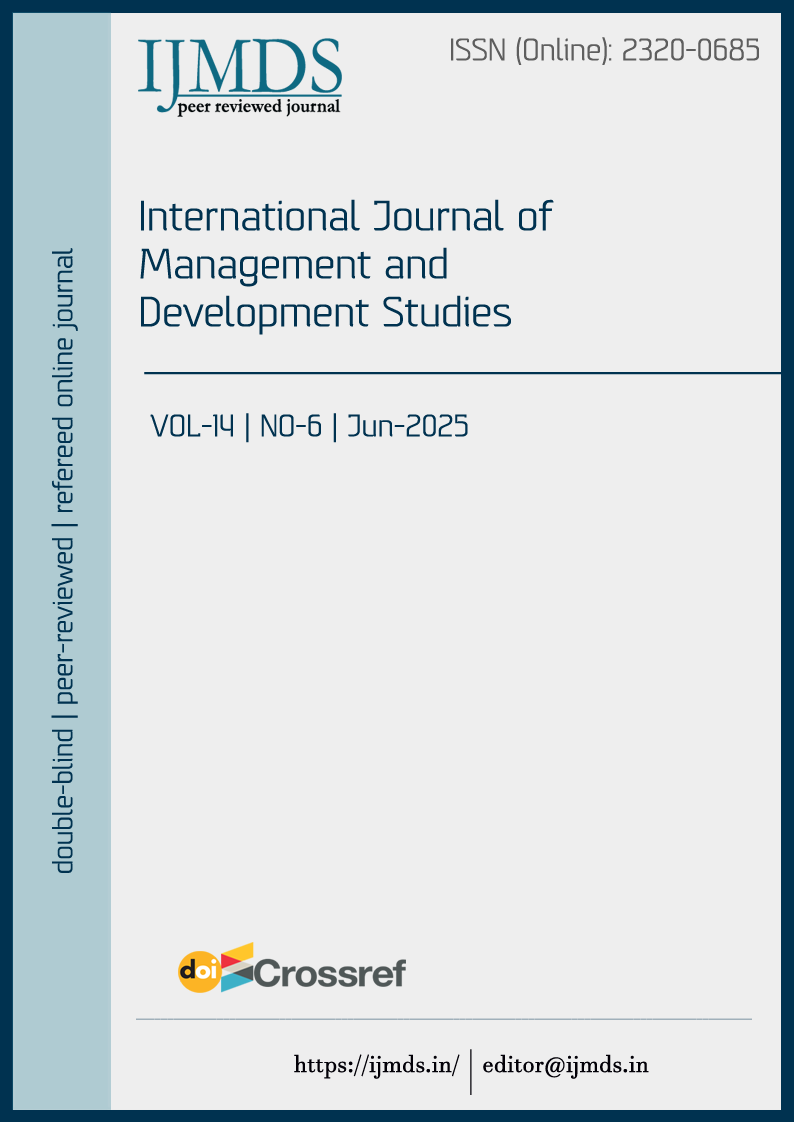The Impact of Personality and Emotional Intelligence on Decision-Making Styles in Organizations
DOI:
https://doi.org/10.53983/ijmds.v14n6.008Keywords:
personality traits, emotional intelligence, decision-making styles, qualitative studyAbstract
This qualitative study investigates how personality traits and emotional intelligence (EI) jointly influence decision-making styles in organizational settings. Drawing upon the Big Five Personality Model, Goleman’s Emotional Intelligence framework, and Scott and Bruce’s decision-making typology, the research explores the lived experiences of 18 mid- to senior-level professionals from diverse sectors including corporate, education, healthcare, and public service. Data were collected through semi-structured interviews and analyzed using thematic analysis. The findings reveal that while personality traits shape default tendencies—such as rationality in conscientious individuals or avoidant behaviour in those high in neuroticism—emotional intelligence plays a critical moderating role. High-EI individuals demonstrated better emotional regulation, interpersonal sensitivity, and ethical awareness, enabling them to adapt their decision-making style according to context. Moreover, emotionally intelligent participants integrated both rational and intuitive strategies, especially in high-pressure or emotionally charged situations. The study underscores the interplay between stable personality traits and flexible emotional capacities in influencing organizational decision-making. It concludes that effective decision-making is best understood through a combined lens of personality and emotional intelligence, with implications for leadership development, HR practices, and organizational training programs.
Downloads
References
Ashkanasy, N. M., & Daus, C. S. (2005). Rumors of the death of emotional intelligence in organizational behavior are vastly exaggerated. Journal of Organizational Behavior, 26(4), 441–452. https://doi.org/10.1002/job.320
Barbuto, J. E., & Burbach, M. E. (2006). The emotional intelligence of transformational leaders: A field study of elected officials. The Journal of Social Psychology, 146(1), 51–64. https://doi.org/10.3200/SOCP.146.1.51-64
Carter, N. T., Dalal, D. K., Boyce, A. S., O’Connell, M. S., Kung, M. C., & Delgado, K. M. (2015). Uncovering curvilinear relationships between conscientiousness and job performance: How theoretically appropriate measurement makes an empirical difference. Journal of Applied Psychology, 100(5), 1484–1503. https://doi.org/10.1037/a0038832
Cherniss, C. (2010). Emotional intelligence: Toward clarification of a concept. Industrial and Organizational Psychology, 3(2), 110–126. https://doi.org/10.1111/j.1754-9434.2010.01231.x
Côté, S. (2014). Emotional intelligence in organizations. Annual Review of Organizational Psychology and Organizational Behavior, 1, 459–488. https://doi.org/10.1146/annurev-orgpsych-031413-091233
Costa, P. T., & McCrae, R. R. (1992). Revised NEO Personality Inventory (NEO-PI-R) and NEO Five-Factor Inventory (NEO-FFI): Professional manual. Psychological Assessment Resources.
Curşeu, P. L., & Sari, K. (2015). Personality characteristics that are valued in teams: Not always "more is better"? International Journal of Psychology, 50(4), 274–285. https://doi.org/10.1002/ijop.12087
Farh, C. I. C., Seo, M. G., & Tesluk, P. E. (2012). Emotional intelligence, teamwork effectiveness, and job performance: The moderating role of job context. Journal of Applied Psychology, 97(4), 890–900. https://doi.org/10.1037/a0027377
Goleman, D. (1995). Emotional intelligence: Why it can matter more than IQ. Bantam Books.
Goleman, D. (1998). Working with emotional intelligence. Bantam Books.
Jordan, P. J., & Troth, A. C. (2004). Managing emotions during team problem solving: Emotional intelligence and conflict resolution. Human Performance, 17(2), 195–218. https://doi.org/10.1207/s15327043hup1702_4
Joseph, D. L., & Newman, D. A. (2010). Emotional intelligence: An integrative meta-analysis and cascading model. Journal of Applied Psychology, 95(1), 54–78. https://doi.org/10.1037/a0017286
Judge, T. A., & Zapata, C. P. (2015). The person–situation debate revisited: Effect of situation strength and trait activation on the validity of the Big Five personality traits in predicting job performance. Academy of Management Journal, 58(4), 1149–1179. https://doi.org/10.5465/amj.2010.0837
Judge, T. A., Higgins, C. A., Thoresen, C. J., & Barrick, M. R. (2002). The Big Five personality traits, general mental ability, and career success across the life span. Personnel Psychology, 52(3), 621–652. https://doi.org/10.1111/j.1744-6570.1999.tb00174.x
Mayer, J. D., Salovey, P., & Caruso, D. R. (2004). Emotional intelligence: Theory, findings, and implications. Psychological Inquiry, 15(3), 197–215. https://doi.org/10.1207/s15327965pli1503_02
McNair, S. J., Feeney, B. C., & Marshall, A. D. (2016). Dependent and avoidant decision-making: The role of agreeableness. Personality and Individual Differences, 94, 239–245. https://doi.org/10.1016/j.paid.2016.01.043
Mikolajczak, M., Luminet, O., & Menil, C. (2007). Predicting resistance to stress: Emotional intelligence moderates the relationship between stress and burnout and health. Journal of Research in Personality, 41(4), 936–946. https://doi.org/10.1016/j.jrp.2006.08.004
Moore, C., & Tenbrunsel, A. E. (2014). “Just think about it?” Cognitive complexity and moral choice. Organizational Behavior and Human Decision Processes, 123(2), 138–149. https://doi.org/10.1016/j.obhdp.2013.10.003
Petrides, K. V., Pita, R., & Kokkinaki, F. (2007). The location of trait emotional intelligence in personality factor space. British Journal of Psychology, 98(2), 273–289. https://doi.org/10.1348/000712606X120618
Schutte, N. S., & Malouff, J. M. (2011). Emotional intelligence mediates the relationship between mindfulness and subjective well-being. Journal of Personality and Individual Differences, 50(7), 1116–1119. https://doi.org/10.1016/j.paid.2011.01.037
Scott, S. G., & Bruce, R. A. (1995). Decision-making style: The development and assessment of a new measure. Educational and Psychological Measurement, 55(5), 818–831. https://doi.org/10.1177/0013164495055005017
Tett, R. P., & Burnett, D. D. (2003). A personality trait-based interactionist model of job performance. Journal of Applied Psychology, 88(3), 500–517. https://doi.org/10.1037/0021-9010.88.3.500
Thunholm, P. (2004). Decision-making style: Habit, style or both? Personality and Individual Differences, 36(4), 931–944. https://doi.org/10.1016/S0191-8869(03)00162-4
Yukl, G. (2013). Leadership in organizations (8th ed.). Pearson.
Zaleskiewicz, T. (2001). Beyond risk seeking and risk aversion: Personality and the dual nature of economic risk taking. European Journal of Personality, 15(S1), S105–S122. https://doi.org/10.1002/per.426
Zhou, Y., Landa, S., & Everts, J. (2016). The role of neuroticism in decision-making: Anxiety, risk-taking, and response inhibition. Personality and Individual Differences, 94, 233–238. https://doi.org/10.1016/j.paid.2016.01.037

